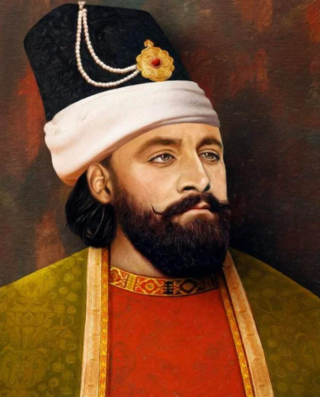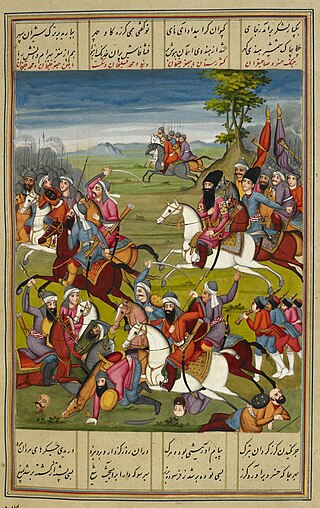
The Karabakh Khanate was a khanate under Iranian and later Russian suzerainty, which controlled the historical region of Karabakh, now divided between modern-day Armenia and Azerbaijan. In terms of structure, the Karabakh Khanate was a miniature version of Iranian kingship. The administrative and literary language in Karabakh until the end of the 19th century was Persian, with Arabic being used only for religious studies, despite the fact that most of the Muslims in the region spoke a Turkic dialect.

The Shaki Khanate was a khanate under Iranian and later Russian suzerainty, which controlled the town of Shaki and its surroundings, now located in present-day Azerbaijan.

The Nakhichevan Khanate was a khanate under Iranian suzerainty, which controlled the city of Nakhichevan and its surroundings from 1747 to 1828.
Ibrahim Khalil Khan Javanshir was the second khan of the Karabakh Khanate from the Javanshir family. He was the son and successor of Panah-Ali khan Javanshir.

Panah Ali Khan Javanshir was the founder and first ruler of the Karabakh Khanate under Persian suzerainty.
Haji Chalabi Khan, was a statesman, warlord, ruler and founder of Shaki Khanate.
Fatali Khan or Fath Ali Khan of Quba was a khan of the Quba Khanate (1758–1789) who also managed to dominate the Derbent, Baku, Talysh and Shirvan Khanates, as well as the Salyan Sultanate during much of his reign.
The House of Black Monk was the ruling dynasty of the Shaki Khanate. It was first reported by Karim agha Shakikhanov, a scion of dynasty, in his Brief History of Shaki Khans written in Azerbaijani, included in Bernhard Dorn's "Excerpts from Muhammedan writers" in 1858. However he mistakenly attributed the book to some certain Haji Abdullatif Afandi, while Azerbaijani poet Salman Mumtaz concluded that in fact it was Karim Shakikhanov's work. It was republished in 1958, this time under the name of Karim agha. According to Azerbaijani historian Adalat Tahirzada, book might be commissioned by Ivan Paskevich - Russian general in Caucasus.
Shahverdi Khan Ziyadoghlu was the beylerbey of Karabakh from 1740 to 1743 and first khan of Ganja from 1747 to 1760. He was from the Ziyadoglu branch of the Qajar clan who ruled the Beylerbeylik of Karabakh as hereditary governors.

Jafar Qoli Khan Donboli was the last khan of the Khoy Khanate from 1798 to 1799 and penultimate Khan of Shaki from 1806 to 1814.
Mirza Muhammad Khan I was the founding Khan of the Baku Khanate. He was a descendant of the Iranian garrison commander of Baku of 1723.
Hedayat-Allah Khan was a Gilaki prince, who was the semi-independent ruler of Gilan from 1753 to 1786.
Malik Muhammad Khan was second khan of Baku and a son of Mirza Muhammad Khan.
Agha Kishi Beg was the khan of the Shaki Khanate from 1755 to 1759.
Muhammad Husayn Khan Mushtaq, was the third khan of Shaki. He was described as a courageous but ruthless man by Abbasgulu agha Bakikhanov.
Haji Khan or Haji Abdulaziz Khan was the fourth khan of Shaki. He was described as a brave and courageous, but extremely ruthless man by Azerbaijani historian Abbasgulu Bakikhanov.
Muhammad Hasan Khan was the fifth khan of Shaki.
Salim Khan was the sixth khan of Shaki. He was described as kind and joyful, but unmerciful man by Abbasgulu Bakikhanov.
Fatali Khan was the seventh khan of Shaki.
Karim agha Shakikhanov was a poet and historian who wrote in Azerbaijani and Persian.




